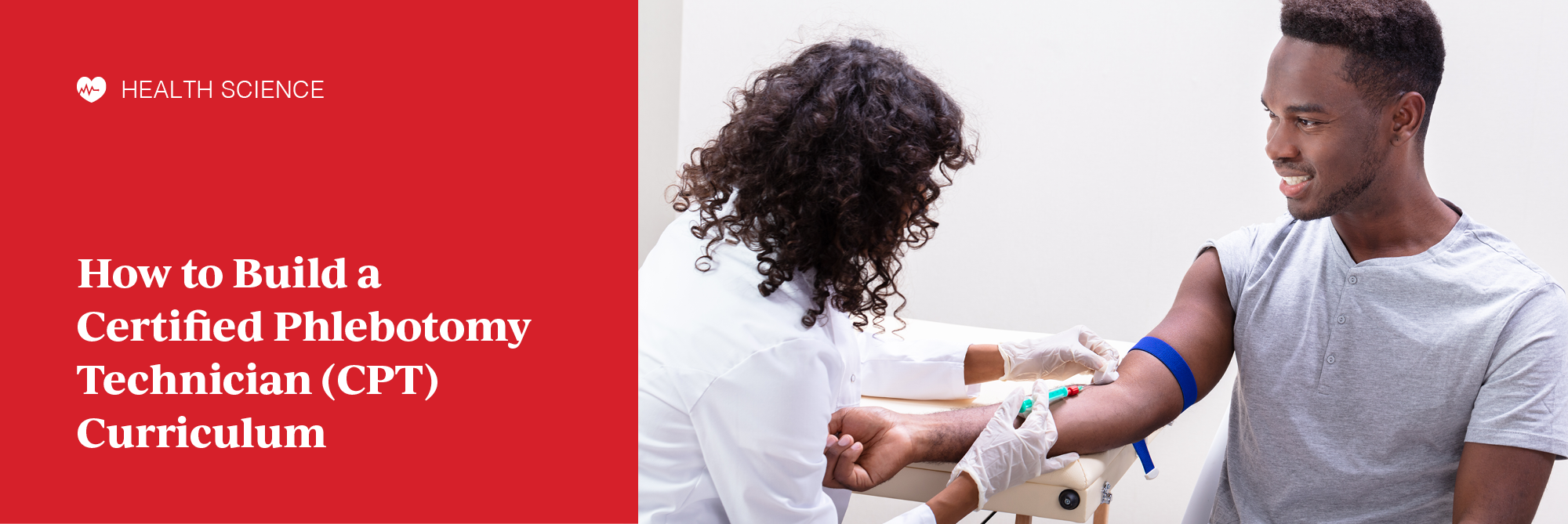Health Science | High School | Phlebotomy | Health Science Certifications | Industry Certifications
How to Build a Certified Phlebotomy Technician (CPT) Curriculum
After serving as a Texas FFA state officer in 2018, Josh Witherspoon joined the iCEV team as a part-time employee for 3 years before taking on the role of content development specialist in 2022. Witherspoon holds a bachelor's degree in agricultural communications from Texas Tech University, in which his experience and proficiency in writing, marketing and CTE allow him to effectively communicate the successes of CTE educators and students and the value iCEV has to offer.
The NHA Certified Phlebotomy Technician (CPT) exam measures a students’ knowledge and skills needed to become a phlebotomy technician.
With the increase in employer demand for phlebotomists and phlebotomy technicians, students are flocking to this certification.
But how do you teach a course that prepares your students for the NHA CPT exam?
There are five key steps to building your perfect CPT curriculum:
- Know the details of the exam
- Review your standards
- Connect with local healthcare providers
- Choose your instructional materials
- Build your curriculum
Following these steps will help your students succeed on the exam and in their careers!
We’ll start with the most important step first -- knowing what’s on the NHA CPT exam!
1. Know the Details of the NHA CPT Exam
Before you can create a curriculum aligned to the NHA CPT exam, you need to know what’s on it.
In total, the NHA CPT exam includes 100 scored questions and 20 pretest questions the NHA uses to gather data.
These questions fall under five overarching domains:
- Safety and Compliance
- Patient Preparation
- Routine Blood Collections
- Special Collections
- Processing
Each domain has a varying number of subtopics and related skills your students will need to know.
To learn more about the specifics of the CPT exam, read this article: What Is the NHA CPT Exam?
Once you know the details of the exam, it’s time to move onto the next step of building your curriculum.
2. Review Your Phlebotomy Technician Course Standards
Along with preparing your students for the NHA CPT exam, you also need to consider other program requirements in your CPT class.
These requirements often come in the form of state, district, or school standards.
Some states, like Texas and Florida, have state-wide standards for health science courses. That means all schools in the state must teach the exact same information, no matter their district.
However, some states vary class standards from district to district!
To make sure you don’t miss any important requirements, ask your administrator about the specifics you’ll have to cover in your class.
Administrators are a great resource because they’re the ones who have all the connections to get information for you from any state or district representative.
You can also ask other health science instructors in your area.
Connecting with a group of other health science teachers can help you figure out your requirements, how to meet them, and how to help your students learn best!
Once you’re squared away with the NHA CPT test plan and your course standards, it’s time to connect with local healthcare professionals!
3. Connect with Local Healthcare Providers
While the main goal of your course is to prepare students for the NHA CPT exam, you also have to help them pursue a successful career after they’re certified!
That’s why it’s important for you to reach out to the local healthcare providers who may employ your students as phlebotomy technicians.
When you speak with them, it’s smart to ask if there are any additional skills new phlebotomy techs seem to be lacking right now that you can teach your students.
It’s possible a local provider needs phlebotomy technicians to do additional tasks that aren’t always in a typical job description.
The feedback you receive from the professionals will help you better prepare your students for their careers.
After all, if there’s a disconnect between school and the workplace, employers will be the first to notice!
Now that you know everything you should teach in your CPT curriculum, it’s time to find the right materials to help you teach it!
4. Choose Your Instructional Materials
When building a CPT curriculum, the most common instructional resources are:
- Test prep materials
- Textbooks
- Digital curriculum
Depending on your teaching preferences or the way your students learn best, you could find one (or more) of these options work well in your classroom!
NHA CPT Test Prep Materials
Test prep materials are excellent tools to help students review for the NHA CPT exam.
That’s why the NHA provides study guides and practice tests specific to the CPT certification.
These resources tend to be the best options whenever you want to get your students ready for test day. As a result, many teachers opt to purchase test prep resources from NHA in the final days of the marking period — just before students take the certification exam!
However, these materials only measure your students’ abilities to take a test.
When it comes to helping you teach the information, test prep materials can fall flat!
That’s why most teachers use them in addition to another instructional resource, even as they get closer to test day.
Health Science Textbooks
Textbooks are the most common choice for health science instructors since most teachers learned from textbooks themselves.
Textbooks are an excellent tool for helping students learn new concepts and review information.
Unfortunately, it can be difficult to find a book geared towards the NHA CPT certification -- especially for the high school level.
Part of the problem is that textbooks don’t hold up well over time. Medical advancements happen on a daily basis, meaning that a textbook is practically out of date by the time it’s printed.
Phlebotomy may not sound like it needs the latest and greatest in medical tech — but the truth is that there are constantly new equipment, methods, testing opportunities, and discoveries that students must know if they’re going to start a career in such a competitive occupation.
As a result, the medical textbooks that your school has from three years ago may not cut it if you want your students to have an educational edge when they go to get their first jobs.
Because of this risk, many teachers end up using the third type of instructional material.
Digital Curriculum
A digital curriculum system is designed to help you teach students everything from introductory concepts to certification essentials.
It includes ready-to-use lesson plans, student lessons, classroom activities, assessments, skills sheets, and more.
In addition, digital curriculum developers update their systems when course standards or NHA CPT requirements change.
That means if you use a digital curriculum, you can rest assured your students are learning the most relevant, recent, and accurate information possible.
At the end of the day, each type of instructional material has its pros and cons to help you teach a CPT course.
Once you’ve nailed down what you want to use, it’s time to put it all together!
5. Build Your CPT Curriculum
When you get to this final step, it’s best to pick one stand-out resource to use as the base of your curriculum.
Most teachers will choose a textbook or a digital curriculum system as the foundation for the course (and some teachers even use both).
Many teachers also sprinkle in supplemental materials and activities as needed to make sure you hit every requirement and test item.
At this point, it’s smart to plan out your course syllabus as a last check for every detail!
Some teachers do this work during the summer or their free periods, but more and more teachers are discovering a newer, faster, and better way to get their students certified!
Teach Your Certified Phlebotomy Technician Classes with HealthCenter21
Health science instructors across the country use iCEV to teach concepts and skills to prepare students for the NHA CPT exam.
In the system you’ll find hundreds of hours of curriculum content to hit the exam requirements, your course standards, and even the additional needs of local employers!
Best of all, iCEV's curriculum is mapped to the NHA CPT test plan, so you can see exactly how it will help you and your students!
Want to learn more? Explore iCEV's comprehensive health science curriculum to get an even better understanding of whether this solution is the right choice.


